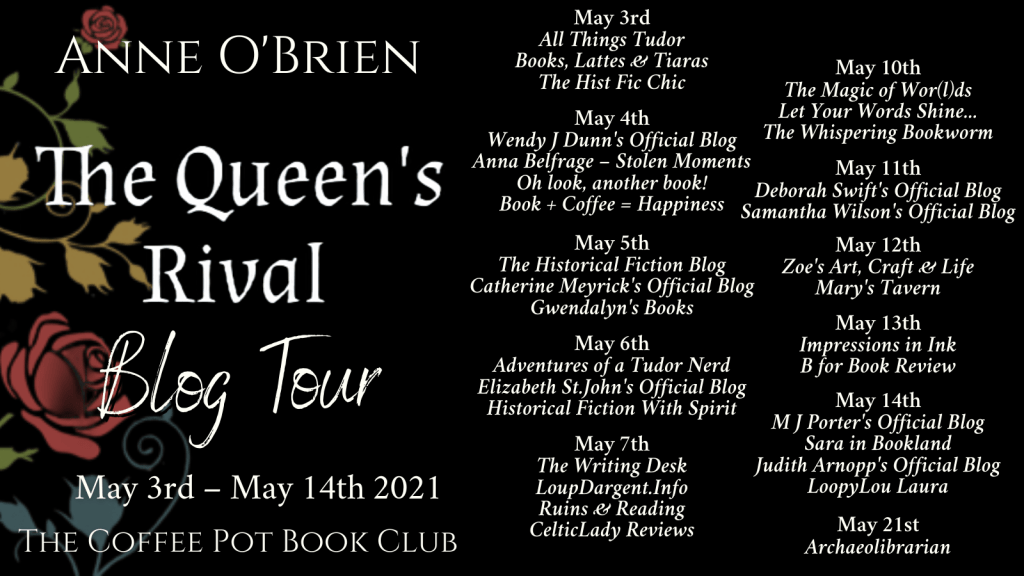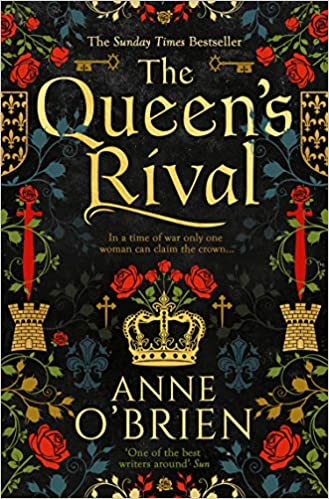Today, I’m delighted to welcome Anne O’Brien to the blog to talk about her fantastic book, The Queen’s Rival, a real favourite of mine. (Find my review here).
I have read Queen’s Rival and I found it riveting. Yet, it is deliciously complex, and there’s a huge amount of both primary and secondary material available for study. Can you explain your research process to me, and give an idea of the resources that you rely on the most (other than your imagination, of course) to bring the historical characters to life?
The complexity of the Wars of the Roses within the story of Cecily Neville was daunting when I first took it on. Where to start, where to end. Should I consolidate into one book, or write a sequel? While I thought about it, all became clear to me. Because I write about medieval women and form their point of view, many of the political events and battles must dealt with lightly, made only relevant when they had a bearing on Cecily’s experience, and then rarely in grat detail. To begin: the day that she became a force in her own right – the events at Ludlow after the debacle at Ludford Bridge when she was left to face the rampaging mob of the Lancastrian army, alone with her three younger children. To end: with the crowning of Richard III when Cecily must come to terms with the political forces that had removed her grandson Edward V from the throne.
Who to include in Cecily’s story?
Some major figures would have to be short-changed because they did not develop the plot that was Cecily’s life, but were merely people on the periphery of Cecily’s story. These included such notable characters as Margaret Beaufort, Anne Neville, Henry Tudor. Even Margaret of Anjou might have demanded a more dynamic role although she is not entirely absent. This may disappoint some readers but these are characters for another book. There is a finite length to a novel as my editor is keen to tell me; Cecily and her family must take pre-eminence.
Cecily was the youngest of a large family. To include all her brothers and sisters would definitely be a bad plan. I deliberately made a choice of those who would be most useful to me Her brother Richard of Salisbury of course and his son the Earl Warwick. Two of her sisters, the eldest and the one closest to her in age. The rest would sadly have to remain anonymous.
Why write in letter format? I chose to do this to develop the family aspect of the Wars of the Roses. These were real people who suffered and rejoiced within their families. I decided that letters would make this a very personal account for Cecily, and thus make the emotion of her losses and achievements even stronger when faced with scandal and treachery.
Mostly when researching I refer to secondary sources. I do not always find the need to return to primary sources. For me this would be like re-inventing the wheel since the history of the Wars of the Roses has been magnificently researched by a number of historians, although I admit to being picky over whom I might use. I find myself returning to the works of Matthew Lewis, Ian Mortimer, Nigel Saul, Anthony Goodman and Michael Jones. For Cecily herself , when I was was half way through writing, a new long-awaited biography of Cecily was published: Cecily Duchess of York by J L Laynesmith which proved endlessly useful for tying up a number of loose ends for me.
For primary sources, the chroniclers of the day are fascinating and encouraged me to write my own version of a Chronicle to help the plot to progress in The Queen’s Rival. Accounts of Cecily’s pious lifestyle in her later years and the vast detail of her will were both excellent.
Taking the facts, together with the reactions of those who knew Cecily, it is then a matter of historical imagination to create an interpretation of her life as accurately as possible.
Do you have a ‘go’ to book/resource that you couldn’t write without having to hand, and if so, what is it?
I don’t have a ‘go to’ book when writing because my medieval women span a number of reigns, but one I find myself referring to frequently is The Senses in Late Medieval England by C M Woolgar. It opens up the medieval world and life in aristocratic households beautifully, from every possible angle. I also have quite a collection of books on medieval armour and costume – an essential part of my research, as well as medieval poetry and chivalric tales. And then there are the general history reference books … Altogether my bookshelves are groaning from the weight of medieval history books.
Thank you so much for sharing your process with me. It’s fascinating and I’m in awe of how you managed to fit so much into one novel!
(Isn’t the cover beautiful).
Here’s the blurb;
England, 1459.
One family united by blood. Torn apart by war…
The Wars of the Roses storm through the country, and Cecily Neville, Duchess of York, plots to topple the weak-minded King Henry VI from the throne.
But when the Yorkists are defeated at the battle of Ludford Bridge, Cecily’s family flee and abandon her to face a marauding Lancastrian army on her own.
Stripped of her lands and imprisoned in Tonbridge Castle, the Duchess begins to spin a web of deceit. One that will eventually lead to treason, to the fall of King Henry VI, and to her eldest son being crowned King Edward IV.
Amazon UK: Amazon US: Amazon CA: Amazon AU:
Barnes and Noble: Waterstones: Kobo:
Meet the author
Sunday Times Bestselling author Anne O’Brien was born in West Yorkshire. After gaining a BA Honours degree in History at Manchester University and a Master’s in Education at Hull, she lived in East Yorkshire for many years as a teacher of history.
Today she has sold over 700,000 copies of her books medieval history novels in the UK and internationally. She lives with her husband in an eighteenth-century timber-framed cottage in the depths of the Welsh Marches in Herefordshire. The area provides endless inspiration for her novels which breathe life into the forgotten women of medieval history.
Follow Anne
Website: Twitter: Facebook: LinkedIn: Pinterest:
Amazon Author Page: Goodreads: News Letter sign up:

Don’t forget to check out the other stops on The Queen’s Rival blog tour with The Coffee Pot Book Club.



